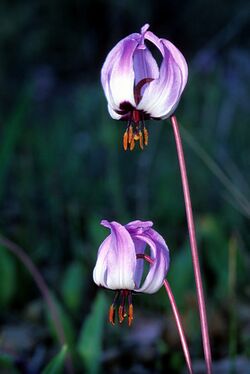Biology:Erythronium hendersonii
| Henderson's fawn lily | |
|---|---|

| |
| Scientific classification | |
| Kingdom: | Plantae |
| Clade: | Tracheophytes |
| Clade: | Angiosperms |
| Clade: | Monocots |
| Order: | Liliales |
| Family: | Liliaceae |
| Subfamily: | Lilioideae |
| Tribe: | Lilieae |
| Genus: | Erythronium |
| Species: | E. hendersonii
|
| Binomial name | |
| Erythronium hendersonii S.Watson
| |
Erythronium hendersonii, or Henderson's fawn lily, is a plant in the lily family native to southwestern Oregon, and northern California .[2] It can be locally very abundant within its range which is in the Rogue River, and Applegate River drainage basins in Josephine County and Jackson County in Oregon, and well as sites in Siskiyou, Del Norte, and Mendocino Counties in California .[3][4]
Description
Erythronium hendersonii has a pair of mottled leaves, and its scape can bear up to eleven blossoms, but more commonly 1–4. The flower color is distinctive among all western North American Erythronium species. The color of the recurved tepals varies from a deep velvety purple, to lavender. The base of the tepals is dark purple, and surrounded by a tinge of white or yellow. The stigma is unlobed to shortly three-lobed, and the anthers are purple to brown.[5][6]
This species is named for Louis F. Henderson, who has been called "The Grand Old Man of Northwest Botany".
Ecology
It blooms early in the southern part of its range starting in February, with some locations carpeted by E. hendersonii in the thousands in March, where it often blooms with Dodecatheon hendersonii. It blooms at higher elevations through May. It is most abundant in dry, open woodlands of Ponderosa pine, Garry oak, and madrone.
Cultivation
In the UK, Erythronium henderonii has received the Royal Horticultural Society's Award of Garden Merit.[7]
References
- ↑ "Erythronium hendersonii". NatureServe Explorer. NatureServe. http://www.natureserve.org/explorer/servlet/NatureServe?searchName=erythronium+hendersonii+.
- ↑ "World Checklist of Selected Plant Families: Royal Botanic Gardens, Kew". http://apps.kew.org/wcsp/namedetail.do?name_id=305774.
- ↑ Calflora taxon report, Erythronium hendersonii S. Watson
- ↑ Clennett, C. (2014). The genus Erythronium: 1-158. Kew Publishing, Kew.
- ↑ Jepson Manual; Erythronium hendersonii
- ↑ Sciences., American Academy of Arts and; Sciences., American Academy of Arts and (1 January 1886). Proceedings of the American Academy of Arts and Sciences.. v. 22, new ser. v. 14 (1886). https://www.biodiversitylibrary.org/page/3054061#page/501/mode/1up.
- ↑ "Erythronium hendersonii". RHS. https://www.rhs.org.uk/Plants/6823/Erythronium-hendersonii/Details.
External links
Wikidata ☰ Q952608 entry
 |


